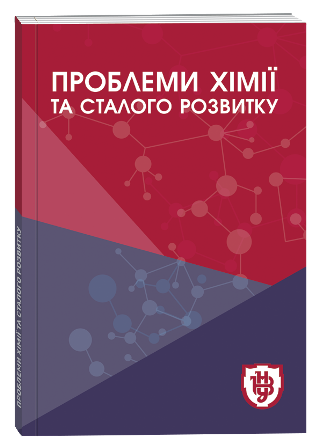ALKALI-ACTIVATED LONG-FLAME COAL. NANOPOROUS STRUCTURE AND ABILITY TO ADSORB HEAVY METALS
DOI:
https://doi.org/10.32782/pcsd-2025-3-7Keywords:
long-flame coal, alkaline activation, carbon material, lead adsorption, π-sorptionAbstract
Purpose. Study of the reorganizatіng supramolecular and porous structure of long-flame coal with increasing alkaline activation temperature, and assessment of its effect on adsorption activity towards lead cations.Methodology. Carbon materials (CMs) were obtained by heating KOH-impregnated coal to one of the temperatures within 350–825°C, isothermal holding for 1 h, cooling, washing from alkali and drying. The elemental composition was determined by a Carlo Erba 1106 analyzer. The content of acidic functional groups (AFG) was determined by Boehm titration. The spatial structure of CMs was studied by X-ray diffraction. The porosity characteristics of CMs were calculated using low-temperature (77 K) nitrogen adsorption–desorption isotherms (2D-NLDFT-HS method). Adsorption of Pb(II) cations was measured at 25°C and a constant CM content (1 g/l) in aqueous solutions. Adsorption kinetics were fitted using pseudo-first and pseudo-second order models. Adsorption isotherms were approximated by Langmuir and Freundlich models.Originality. The adsorption activity towards Pb(II) of carbon materials obtained by alkaline activation of long-flame coal at different temperatures at a small KOH/coal ratio (1 g/g) was studied for the first time. The adsorption equilibrium was found to be reached for 2 h, the adsorption kinetics obey the pseudo-second-order model, and the adsorption isotherms are better approximated by the Langmuir model. The adsorption rate is limited by the interaction of cations with surface adsorption centers, rather than diffusion into the porous system. The activation temperature was determined to be a key factor of forming CMs nanoporosity and ability to adsorb Pb(II) cations. With increasing temperature, the adsorption capacities of the cations monolayer, calculated from the Langmuir equation, increase from 0.143 mmol/g to 0.981 mmol/g.The basic processes of Pb(II) adsorption by CMs samples from long-flame coal is established to be ion-exchange reactions (exchange of AFGs protons for Pb(II)) and π-sorption (interaction of Pb(II) with the π-system of coal polyarenes). The contribution of π-sorption was shown to increase with the activation temperature and is dominant (87–91%) in materials obtained at 800–825°C. The sufficiently high capacity for Pb(II) of these CMs allows us to predict their effectiveness in purifying water from other heavy metals.
References
Tiwari D., Bhunia H., Bajpai P.K. Adsorption of CO2 on KOH activated, N-enriched carbon derived from urea formaldehyde resin: kinetics, isotherm and thermodynamic studies. Appl. Surf. Sci., 2018. Vol. 439. P. 760–771. https://doi.org/10.1016/j.apsusc.2017.12.203
So S.H., Lee S., Mun J., Rho J., Park C.R. What induces the dense storage of hydrogen of liquid– or solid-like density levels in carbon nanopores with sub-1 nm diameters. Carbon, 2023. Vol. 204. P. 594–600. https://doi.org/10.1016/j.carbon.2022.12.057
KumarK.V., Preuss K., Titirici M.-M., Rodríguez-Reinoso F. Nanoporous materials for the onboard storage of natural gas. Chem. Rev., 2017. Vol. 117. Is. 3. P. 1796–1825. https://doi.org/10.1021/acs.chemrev.6b00505
Bora M., Bhattacharjya D., Saikia B.K. Coal-derived activated carbon for electrochemical energy storage: status on supercapacitor, Li-Ion battery, and Li–S battery applications. Energy Fuels,. 2021. Vol. 35. Is. 22. P.18285–18307. https://doi.org/10.1021/acs.energyfuels.1c02518
Ma Z., Han Y., Qi J., Qu Z., Wang X. High iodine adsorption by lignin-based hierarchically porous flower-like carbon nanosheets. Industrial Crops and Products, 2021. Vol. 169. Article 113649. https://doi.org/10.1016/j.indcrop.2021.113649
Malini K., Selvakumar D., Kumar N.S. Activated carbon from biomass: Preparation, factors improving basicity and surface properties for enhanced CO2 capture capacity – A review. Journal of CO2 Utilization. 2023. Vol. 67. Article 102318. https://doi.org/10.1016/j.jcou.2022.102318
Zhao C., Ge L., Mai L., Li X., Chen S., Li Q., Li S., Yao L., Wang Y., Xu C. Review on coal-based activated carbon: preparation, modification, application, regeneration, and perspectives. Energy Fuels, 2023. Vol. 37. Is. 16. P. 11622–11642. https://doi.org/10.1021/acs.energyfuels.3c01866
Mishra R.K., Singh B., Acharya B. A comprehensive review on activated carbon from pyrolysis of lignocellulosic biomass: An application for energy and the environment. Carbon Resources Conversion, 2024. Vol, 7. Is. 4. Article 100228. https://doi.org/10.1016/j.crcon.2024.100228
Kaur B., Gupta R.K., Bhunia H. Chemically activated nanoporous carbon adsorbents from waste plastic for CO2 capture: Breakthrough adsorption study. Micropor. Mesopor. Mater., 2019. Vol. 282. P. 146–158. https://doi.org/10.1016/j.micromeso.2019.03.025
Chaudhary P., Bansal S., Sharma B.B., Saini S., Joshi A. Waste biomass-derived activated carbons for various energy storage device applications: A review. J. Energy Storage, 2024. Vol. 78. Article 109996. https://doi.org/10.1016/j.est.2023.109996
Yan L., Sorial G.A. Chemical activation of bituminous coal for hampering oligomerization of organic contaminants. J. Hazard. Mater., 2011. Vol. 197. P. 311–319. https://doi.org/10.1016/j.jhazmat.2011.09.093
Li H., Budarin V.L., Clark J.H., North M., Wu X. Rapid and efficient adsorption of methylene blue dye from aqueous solution by hierarchically porous, activated starbons®: Mechanism and porosity dependence. J. Hazard. Mater., 2022. Vol. 436. Article 129174. https://doi.org/10.1016/j.jhazmat.2022.129174
Hamyali H., Nosratinia F., Rashidi A., Ardjmand M. Anthracite coal-derived activated carbon as an effectiveness adsorbent for superior gas adsorption and CO2 / N2 and CO2 / CH4 selectivity: Experimental and DFT study. J. Environ. Chem. Eng., 2022. Vol. 10. Is.1. Article 107007. https://doi.org/10.1016/j.jece.2021.107007
Zhu S., Xu J., Xie J., Zhang Z., Ding Q., Chen K. Ultrafast dyeing wastewater purification by high-performance and reusable lignin-derived activated porous carbon filter. Separation and Purification Technology, 2024. Vol. 349. Article 127672. https://doi.org/10.1016/j.seppur.2024.127672
Yoshizawa N., Maruyama K., Yamada Y., Ishikawa E., Kobayashi M., Toda Y., Shiraishi M. XRD evaluation of KOH activation process and influence of coal rank. Fuel, 2002. Vol. 81. Is. 13. P. 1717–1722. https://doi.org/10.1016/ S0016-2361(02)00101-1
Zhao X.-Y., Huang S.-S., Cao J.-P., Xi S.-C., Wei X.-Y., Kamamoto J., Takarada T. KOH activation of a HyperCoal to develop activated carbons for electric double-layer capacitors. J. Anal. Appl. Pyrolysis. 2014. Vol. 105. P. 116-121. https://doi.org/10.1016/j.jaap.2013.10.010
Кучеренко В.О., Тамаркіна Ю.В., Абакумов О.О. Формування мікропористої структури довгополуменевого вугілля при лужній активації. Вплив температури. Хімія, фізика та технологія поверхні. 2024. Т. 15. № 2. С. 241–254. https://doi.org/10.15407/hftp15.02.241
Zhang X., Chen W. Mechanisms of pore formation on multi-wall carbon nanotubes by KOH activation. Micropor. Mesopor. Mater. 2015. Vol. 206. P. 194–201. https://doi.org/10.1016/j.micromeso.2014.12.002
Тамаркіна Ю.В., Аніщенко В.М., Редько А.М., Кучеренко В.О. Адсорбційні властивості викопного вугілля, активованого гідроксидом калію. Вплив ступеня метаморфізму. Хімія, фізика та технологія поверхні. 2020. Т. 11. № 2. С. 175–189. https://doi.org/10.15407/hftp11.02.175
Тамаркіна Ю.В., Аніщенко В.М., Редько А.М., Кучеренко В.О. Активоване лугом викопне вугілля. Мікропориста структура та здатність адсорбувати фенольні сполуки. Хімія, фізика та технологія поверхні. 2022. Т. 13. № 1. С. 111–124. https://doi.org/10.15407/hftp13.01.111
Редько А.В., Тамаркіна Ю.В., Кучеренко В.О. Нанопористі матеріали з довгополуменевого вугілля для очищення води від барвника метиленового блакитного. Український журнал природничих наук. 2024. № 8, С. 155–167. https://doi.org/10.32782/naturaljournal.8.2024.1
Кучеренко В.О., Тамаркіна Ю.В., Редько А.В., Сабєрова В.О. Адсорбенти 4-хлорфенолу з довгополуменевого вугілля, активованого гідроксидом калію. Питання хімії та хімічної технології. 2024. № 2, С. 47–54. https:// doi.org/10.32434/0321-4095-2024-153-2-47-54
Biswal B.K., BalasubramanianR. Use of biochar as a low-cost adsorbent for removal of heavy metals from water and wastewater: A review. J. Environ. Chem. Eng. 2023. Vol. 11. Is. 5. Article 110986. https://doi.org/10.1016/j.jece.2023.110986
Ghorbani M., Seyedin O., Aghamohammadhassan M. Adsorptive removal of lead (II) ion from water and wastewater media using carbon-based nanomaterials as unique sorbents: A review. J. Environ. Manage. 2020. Vol. 254. Article 109814. https://doi.org/10.1016/j.jenvman.2019.109814
Momčilović M., Purenović M., Bojić A., Zarubica A., Ranđelović M. (). Removal of lead(II) ions from aqueous solutions by adsorption onto pine cone activated carbon. Desalination. 2011. Vol. 276. Is. 1–3. P. 53–59. https://doi.org/ 10.1016/j.desal.2011.03.013
Li M., Zeng F., Chang H., Xu B., Wang W. Aggregate structure evolution of low-rank coals during pyrolysis by in-situ X-ray diffraction. Int. J. Coal Geol. 2013. Vol. 116–117. P. 262–269. https://doi.org/10.1016/j.coal.2013.07.008
Li H., Hou Y., He Z., Wei J., Ren S., Wu W. Structural evolution characteristics of lignite during pyrolysis based on alkaline-oxygen oxidation, NMR and FTIR. J. Anal. Appl. Pyrolysis. 2023. Vol. 172. Article 105980. https://doi.org/10.1016/j.jaap.2023.105980.
Jagiello J., Kyotani T., Nishihara H. Development of a simple NLDFT model for the analysis of adsorption isotherms on zeolite templated carbon (ZTC). Carbon. 2020. Vol. 169. P. 205–213. https://doi.org/10.1016/j.carbon.2020.06.032
Thommes M., Kaneko K., Neimark A.V., Olivier J.P., Rodriguez-Reinoso F., Rouquerol J., Sing K.S.W. Physisorption of gases. with special reference to the evaluation of surface area and pore size distribution (IUPAC Technical Report). Pure Appl. Chem. 2015. Vol. 87. Is. 9–10. P. 1051–1069. https://doi.org/10.1515/pac-2014-1117
Редько А.В., Тамаркіна Ю.В., Редько А.М., Фролова І.Б., Кучеренко В.О. Спрямованість змін пористої структури і адсорбційної здатності при топохімічному окиснені активованого лугом викопного вугілля. Питання хімії та хімічної технології. 2023. № 2. С. 127–136. https://doi.org/10.32434/0321-4095-2023-147-2-127-136
Revellame E.D., Fortela D.L., Sharp W., Zappi M.E. Adsorption kinetic modeling using pseudo-first order and pseudo-second order rate laws: A review. Cleaner Eng. Technol. 2020. Vol. 1. Article 100032. https://doi.org/10.1016/j.clet.2020.100032
Al-Ghouti M.A., Da’ana D.A. Guidelines for the use and interpretation of adsorption isotherm models: A review. J. Hazardous Materials. 2020. Vol. 393. Article 122383. https://doi.org/10.1016/j.jhazmat.2020.122383
Asuquo E., Martin A., Nzerem P., Siperstein F., Fan X. Adsorption of Cd(II) and Pb(II) ions from aqueous solutions using mesoporous activated carbon adsorbent: Equilibrium, kinetics and characterisation studies. J. Environ. Chem. Eng., 2017. Vol. 5. Is. 1. P. 679–698. https://doi.org/10.1016/j.jece.2016.12.043
Qiu B., Tao X., Wang H., Li W., Ding X., Chu H. Biochar as a low-cost adsorbent for aqueous heavy metal removal: A review. J. Anal. Appl. Pyrolysis. 2021. Vol. 155. Article 105081. https://doi.org/10.1016/j.jaap.2021.105081
Jiang J., Li R., Yang K., Li Y., Deng L., Che D. Investigation on Pb2+ adsorption characteristics by AAEMs-rich biochar in aqueous solution: Performance and mechanism. Environmental Research. 2023. Vol. 236. Part 1. Article 116731. https://doi.org/10.1016/j.envres.2023.116731
Liu Y., Chen Y., Li Y., Chen L., Jiang H., Jiang L., Yan H., Zhao M., Hou S., Zhao C., Chen Y. Elaborating the mechanism of lead adsorption by biochar: Considering the impacts of water-washing and freeze-drying in preparing biochar. Bioresource Technology. 2023. Vol. 386. Article 129447. https://doi.org/10.1016/j.biortech.2023.129447
Mahadevi A.S., Sastry G.N. Cation−π Interaction: Its Role and Relevance in Chemistry, Biology, and Material Science. Chem. Rev. 2013. Vol. 113. Is. 3. P. 2100–2138. https://doi.org/10.1021/cr300222d
Guo B.C., Purnell J.W., Castleman Jr. A.W. The clustering reactions of benzene with sodium and lead ions. Chem. Phys. Letters. 1990, Vol. 168. Is. 2. P. 155–160. https://doi.org/10.1016/0009-2614(90)85122-S








